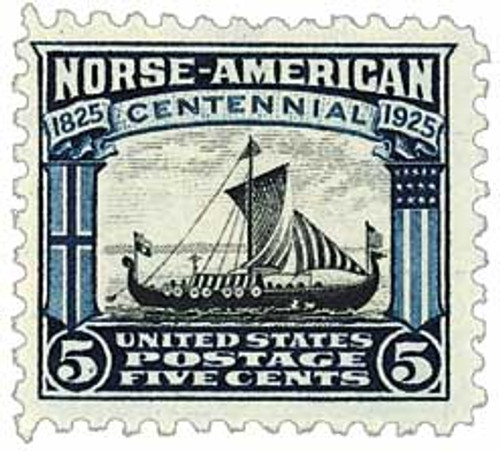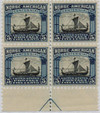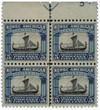
1925 5c Norse-American Centennial: Viking Ship
# 621 - 1925 5c Norse-American Centennial: Viking Ship
$14.00 - $3,650.00
U.S. # 621
1925 Norse-American
5c Viking Ship
- First two-color commemorative since the 1901 Pan-American Series
- Commemorates the arrival of the first Norwegian immigrants to America
- Publicizes the 1925 Norse-American Centennial
Stamp Category: Commemorative
Set: Part of two-stamp set
Value: Five cents
First Day of Issue: May 18, 1925
First Day City: Algona, IA; Benson, MN; Northfield, MN; Decorah, IA; Minneapolis, MN; St. Paul, MN; Washington, D.C.
Quantity Issued: 1,900,983
Printed by: Bureau of Engraving and Printing
Printing Method:Â Flat Plate
First Day City: Algona, IA; Benson, MN; Northfield, MN; Decorah, IA; Minneapolis, MN; St. Paul, MN; Washington, D.C.
Quantity Issued: 1,900,983
Printed by: Bureau of Engraving and Printing
Printing Method:Â Flat Plate
Format: Printed in sheets of 100 stamps 10 by 10, with selvage on four sides
Perforation: 11
Color: Dark blue and black
Color: Dark blue and black
Issued with a dual purpose: To publicize the June 6-9, 1925 Norse-American Centennial celebration held at the Minnesota State Fair and to commemorate the Oct 9, 1825 arrival of the first Norwegians.
About the Stamp Design: The 5c stamp shows a Viking ship, based on the 1893 photo from the Columbian Worlds Fair. That ship,the Vikings was built in 1893 in Norway, sailed across the Atlantic and into the Great Lakes to Chicago for the fair. At 76 feet long, the ship was open with one small sail. A dragons head adorned the front and dragons tail at the end.
Each side has a vertical banner, Norwegian flag on the left and United States flag on right. Top has name of stamp, Norse-American, followed by 1825-1925 Centennial. Â Bottom: United States Postage Five Cents.
Why definitive size? We don,t know the answer. It's unusual for a commemorative to be definitive size and be printed in sheets of 100 with selvage on four sides. This stamp has no straight-edges, also unusual for commemoratives in the 1920s.
Printing. Printed in sheets of 100 with selvage on four sides. The sheet has two plate numbers on the top of the sheet, one for each color, and four arrows in the center of the selvage, top, left, bottom, right. The arrows created a center-line block in the center of the sheet. Each sheet has one plate number block of 8 stamps. The black plate number is over the 4th stamp and second color over the 7th stamp.
Why no inverts? The Bureau of Engraving and Printing had two big challenges with this issue. One was avoiding creating inverts like the 1918 inverted Jenny by printing the ship upside-down. The second, and equally difficult problem, was to keep the 2c and 5c plates, and partly printed sheets separate. Any mix-up might have the 5c Viking ship vignette printed with the 2c frame or visa-versa.
This was the first 2-color commemorative since the 1901 Pan-American series.
Nice sheets are very difficult to find. Most have repairs for perforation separations.
First Day Cities: These cities were in areas near the Norse-American Centennial celebration at the Minnesota State Fair June 6-9, 1925, and areas with many Norse-Americans. All stamps of this era had a Washington D.C. first day cancel.
The five-cent stamp was used for heavier domestic mail and overseas mail.
The Set: Two stamps were issued, #620-21. The 2c is carmine and black. The 5c is dark blue and black.
History the stamp represents: May 1, 1893 the Gokstad-find or Viking Ship left Norway with a crew of twenty. She arrived Newfoundland May 28, sailed the St. Lawrence River and Great Lakes, and reached Chicago for the Columbian Worlds Fair July 13. The ship stayed on display in Chicago after the fair ended. In 1994 it was moved to Good Templar Park in Geneva, IL. It's the largest remaining artifact of the 1893 Columbian Worlds Fair.
When issued, some thought the U.S. & Norwegian flags was a design error. It wasn't The 1893 ship flew both flags.
History of the 1825 Voyage: The first Norwegians arrived in New York Harbor October 9, 1825 on the ship Restaurationen, shown on the sets two-cent value (#621). 52 people arrived three months after leaving Norway. The small ship, 54 feet long and 16 feet wide, had more passengers that allowed by the 1819 Passenger Act. The U.S.welcomed the immigrants by impounding the ship, arresting the captain, and imposing a stiff fine. Happily, for the captain, on November 15, 1825 President John Quincy Adams freed the captain, rescinded the fine, and released the ship.
October 9, the day the Norwegians arrived, is celebrated in the U.S., as Leif Ericson Day. Leif Ericson, Norse explorer, is believed to be the first European to reach North America. Ericson is honored on US #1359, a 6c commemorative issued in 1968.
U.S. # 621
1925 Norse-American
5c Viking Ship
- First two-color commemorative since the 1901 Pan-American Series
- Commemorates the arrival of the first Norwegian immigrants to America
- Publicizes the 1925 Norse-American Centennial
Stamp Category: Commemorative
Set: Part of two-stamp set
Value: Five cents
First Day of Issue: May 18, 1925
First Day City: Algona, IA; Benson, MN; Northfield, MN; Decorah, IA; Minneapolis, MN; St. Paul, MN; Washington, D.C.
Quantity Issued: 1,900,983
Printed by: Bureau of Engraving and Printing
Printing Method:Â Flat Plate
First Day City: Algona, IA; Benson, MN; Northfield, MN; Decorah, IA; Minneapolis, MN; St. Paul, MN; Washington, D.C.
Quantity Issued: 1,900,983
Printed by: Bureau of Engraving and Printing
Printing Method:Â Flat Plate
Format: Printed in sheets of 100 stamps 10 by 10, with selvage on four sides
Perforation: 11
Color: Dark blue and black
Color: Dark blue and black
Issued with a dual purpose: To publicize the June 6-9, 1925 Norse-American Centennial celebration held at the Minnesota State Fair and to commemorate the Oct 9, 1825 arrival of the first Norwegians.
About the Stamp Design: The 5c stamp shows a Viking ship, based on the 1893 photo from the Columbian Worlds Fair. That ship,the Vikings was built in 1893 in Norway, sailed across the Atlantic and into the Great Lakes to Chicago for the fair. At 76 feet long, the ship was open with one small sail. A dragons head adorned the front and dragons tail at the end.
Each side has a vertical banner, Norwegian flag on the left and United States flag on right. Top has name of stamp, Norse-American, followed by 1825-1925 Centennial. Â Bottom: United States Postage Five Cents.
Why definitive size? We don,t know the answer. It's unusual for a commemorative to be definitive size and be printed in sheets of 100 with selvage on four sides. This stamp has no straight-edges, also unusual for commemoratives in the 1920s.
Printing. Printed in sheets of 100 with selvage on four sides. The sheet has two plate numbers on the top of the sheet, one for each color, and four arrows in the center of the selvage, top, left, bottom, right. The arrows created a center-line block in the center of the sheet. Each sheet has one plate number block of 8 stamps. The black plate number is over the 4th stamp and second color over the 7th stamp.
Why no inverts? The Bureau of Engraving and Printing had two big challenges with this issue. One was avoiding creating inverts like the 1918 inverted Jenny by printing the ship upside-down. The second, and equally difficult problem, was to keep the 2c and 5c plates, and partly printed sheets separate. Any mix-up might have the 5c Viking ship vignette printed with the 2c frame or visa-versa.
This was the first 2-color commemorative since the 1901 Pan-American series.
Nice sheets are very difficult to find. Most have repairs for perforation separations.
First Day Cities: These cities were in areas near the Norse-American Centennial celebration at the Minnesota State Fair June 6-9, 1925, and areas with many Norse-Americans. All stamps of this era had a Washington D.C. first day cancel.
The five-cent stamp was used for heavier domestic mail and overseas mail.
The Set: Two stamps were issued, #620-21. The 2c is carmine and black. The 5c is dark blue and black.
History the stamp represents: May 1, 1893 the Gokstad-find or Viking Ship left Norway with a crew of twenty. She arrived Newfoundland May 28, sailed the St. Lawrence River and Great Lakes, and reached Chicago for the Columbian Worlds Fair July 13. The ship stayed on display in Chicago after the fair ended. In 1994 it was moved to Good Templar Park in Geneva, IL. It's the largest remaining artifact of the 1893 Columbian Worlds Fair.
When issued, some thought the U.S. & Norwegian flags was a design error. It wasn't The 1893 ship flew both flags.
History of the 1825 Voyage: The first Norwegians arrived in New York Harbor October 9, 1825 on the ship Restaurationen, shown on the sets two-cent value (#621). 52 people arrived three months after leaving Norway. The small ship, 54 feet long and 16 feet wide, had more passengers that allowed by the 1819 Passenger Act. The U.S.welcomed the immigrants by impounding the ship, arresting the captain, and imposing a stiff fine. Happily, for the captain, on November 15, 1825 President John Quincy Adams freed the captain, rescinded the fine, and released the ship.
October 9, the day the Norwegians arrived, is celebrated in the U.S., as Leif Ericson Day. Leif Ericson, Norse explorer, is believed to be the first European to reach North America. Ericson is honored on US #1359, a 6c commemorative issued in 1968.

















